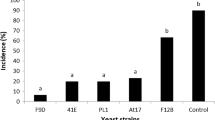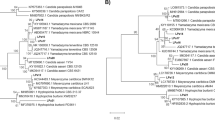Abstract
The objectives of this work were to assess the optimum conditions for induction of acid tolerance in the marine yeast Rhodosporidium paludigenum and evaluate the biocontrol activity of non-adapted and acid-adapted yeasts in controlling apple blue mold caused by Penicillium expansum. R. paludigenum grown in malic and lactic acid treatments were stimulated after 12 h incubation. Moreover, medium modified with malic and lactic acid significantly enhanced the acid tolerance of R. paludigenum (p < 0.05). In acid tolerance response test, the highest viability of R. paludigenum was obtained at initial pH of 5.5 in the NYDB medium modified with malic acid (91.6 %). In addition, all R. paludigenum treatments significantly reduced the disease incidences and lesion diameters of blue mold in apples. Furthermore, there was no significant difference between acid-adapted and unadapted yeasts in the apple wounds after 48 h dynamics. Acid stress improved R. paludigenum viability under acidic conditions. However, there was no significant difference between acid-adapted and unadapted yeasts in controlling P. expansum on apple fruit (p < 0.05). These results indicate the potential for maintaining the survival level of biocontrol agents by physiological inducement strategy.




Similar content being viewed by others
References
Arneborg H, Moos N, Jakobsen M (1995) The effect of acetic acid and specific growth rate on acetic acid tolerance and trehalose content of Saccharomyces cerevisiae. Biotechnol Lett 17:1299–1304
Cañamás PT, Viñas I, Abadias M, Usall J, Torres R, Teixidó N (2009) Acid tolerance response induced in the biocontrol agent Pantoea agglomerans CPA-2 and effect on its survival ability in acidic environments. Microbiol Res 164:438–450
Chorianopoulos N, Giaouris E, Grigoraki I, Skandamis P, Nychas G (2011) Effect of acid tolerance response (ATR) on attachment of Listeria monocytogenes Scott A to stainless steel under extended exposure to acid or/and salt stress and resistance of sessile cells to subsequent strong acid challenge. Int J Food Microbiol 145:400–406
Costa E, Usall J, Teixidó N, Delgado J, Viñas I (2002) Water activity, temperature, and pH effects on growth of the biocontrol agent Pantoea agglomerans CPA-2. Can J Microbiol 48:1082–1088
Greenacre EJ, Brocklehurst TF, Waspe CR, Wilson DR, Wilson PDG (2003) Salmonella enterica serovar Typhimuriumand Listeria monocytogenes acid toleranceresponse induced by organic acids at 20 °C: optimizationand modeling. Appl Environ Microbiol 69:3945–3951
Huang H, Fu G, Yang Z, Zhang J, Jin Z (2012) Effect of protected cultivation to the development and quality of Myrica rubra. J Nanjing For Univ 36:47–52
Kren A, Mamnun YM, Bauer BE, Schüller C, Wolfger H, Hatzixanthis K, Mollapour M, Gregori C, Piper P, Kuchler K (2003) War1p, a novel transcription factor controlling weak acid stress response in yeast. Mol Cell Biol 23:1775–1785
Lahlali R, Jijakli M (2009) Enhancement of the biocontrol agent Candida olephila (strain O) survival and control efficiency under extreme conditions of water activity and relative humidity. Biol Control 51:403–408
Ravishankar S, Harrison MA (1999) Acid adaptation ofListeria monocytogenes strains does not offer cross-protectionagainst an activated lactoperoxidase system. JFood Protect 62:670–673
Stratford M (1999) Traditional preservatives – organic acids. In: Robinson RK, Batt CA, Patel PD (eds) Encyclopedia of Food Microbiology vol 3. Academic, London, pp 1729–1737
Teixidó N, Vinas I, Usall J, Magan N (1998) Improving ecological fitness and environmental stress tolerance of the biocontrol yeast Candida sake by manipulation of intracellular sugar alcohol and sugar content. Mycol Res 102:1409–1417
Teixidó N, Canamas TP, Usall J, Torres R, Magan N, Vinas I (2005) Accumulation of the compatible solutes, glycine-betaine and ectoine, in osmotic stress adaptation and heat shock cross-protection in the biocontrol agent Pantoea agglomerans CPA-2. Lett Appl Microbiol 41:248–252
Teixidó N, Canamas TP, Abadiasm M, Usall J, Solsona C, Casals C, Vinas I (2006) Improving low water activity and desiccation tolerance of the biocontrol agent Pantoea agglomerans CPA-2 by osmotic treatments. J Appl Microbiol 101:927–937
Wang Y, Bao Y, Shen D, Feng W, Yu T, Zhang J, Zheng X (2008) Biocontrol of Alternaria alternata on cherry tomato fruit by use of marine yeast Rhodosporidium paludigenum Fell & Tallman. Int J Food Microbiol 123:234–239
Wang Y, Yu T, Xia J, Yu D, Wang J, Zheng X (2010a) Biocontrol of postharvest gray mold of cherry tomatoes with the marine yeast Rhodosporidium paludigenum. Biol Control 53:178–182
Wang Y, Ren X, Song X, Yu T, Lu H, Wang P, Wang J, Zheng X (2010b) Control of postharvest decay on cherry tomatoes by marine yeast Rhodosporidium paludigenum and calcium chloride. J Appl Microbiol 109:651–656
Wang Y, Wang P, Xia J, Yu T, Lou B, Wang J, Zheng X (2010c) Effect of water activity on stress tolerance and biocontrol activity in antagonistic yeast Rhodosporidium paludigenum. Int J Food Microbiol 143:103–108
Wang Y, Tang F, Xia J, Yu T, Wang J, Azhati R, Zheng X (2011) A combination of marine yeast and food additive enhances preventive effects on postharvest decay of jujubes (Zizyphus jujuba). Food Chem 125:835–840
Wong H-C, Peng P-Y, Han J-M, Chang C-Y, Lan S-L (1998) Effect of mild acid treatment onthe survival, enteropathogenicity, and protein productionin Vibrio parahaemolyticus. Infect Immun 66:3066–3071
Acknowledgments
This research was supported by grants from the National Natural Science Foundation of China (31271962) and Ph.D. Programs Foundation of Ministry of Education of China (20100101110087) and Program for Key Innovative Research Team of Zhejiang Province (2009R50036) and the Special Fund for Agro-scientific Research in the Public Interest of China (200903044).
Author information
Authors and Affiliations
Corresponding authors
Rights and permissions
About this article
Cite this article
Wang, Y., He, S., Xia, J. et al. Acid adaptation and biocontrol efficacy of antagonistic marine yeast Rhodosporidium paludigenum . Ann Microbiol 64, 503–508 (2014). https://doi.org/10.1007/s13213-013-0681-2
Received:
Accepted:
Published:
Issue Date:
DOI: https://doi.org/10.1007/s13213-013-0681-2




